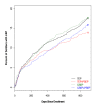Brief psychosocial education, not core stabilization, reduced incidence of low back pain: results from the Prevention of Low Back Pain in the Military (POLM) cluster randomized trial
- PMID: 22126534
- PMCID: PMC3286400
- DOI: 10.1186/1741-7015-9-128
Brief psychosocial education, not core stabilization, reduced incidence of low back pain: results from the Prevention of Low Back Pain in the Military (POLM) cluster randomized trial
Abstract
Background: Effective strategies for the primary prevention of low back pain (LBP) remain elusive with few large-scale clinical trials investigating exercise and education approaches. The purpose of this trial was to determine whether core stabilization alone or in combination with psychosocial education prevented incidence of low back pain in comparison to traditional lumbar exercise.
Methods: The Prevention of Low Back Pain in the Military study was a cluster randomized clinical study with four intervention arms and a two-year follow-up. Participants were recruited from a military training setting from 2007 to 2008. Soldiers in 20 consecutive companies were considered for eligibility (n = 7,616). Of those, 1,741 were ineligible and 1,550 were eligible but refused participation. For the 4,325 Soldiers enrolled with no previous history of LBP average age was 22.0 years (SD = 4.2) and there were 3,082 males (71.3%). Companies were randomly assigned to receive traditional lumbar exercise, traditional lumbar exercise with psychosocial education, core stabilization exercise, or core stabilization with psychosocial education, The psychosocial education session occurred during one session and the exercise programs were done daily for 5 minutes over 12 weeks. The primary outcome for this trial was incidence of low back pain resulting in the seeking of health care.
Results: There were no adverse events reported. Evaluable patient analysis (4,147/4,325 provided data) indicated no differences in low back incidence resulting in the seeking of health care between those receiving the traditional exercise and core stabilization exercise programs. However, brief psychosocial education prevented low back pain episodes regardless of the assigned exercise approach, resulting in a 3.3% (95% CI: 1.1 to 5.5%) decrease over two years (numbers needed to treat (NNT) = 30.3, 95% CI = 18.2 to 90.9).
Conclusions: Core stabilization has been advocated as preventative, but offered no such benefit when compared to traditional lumbar exercise in this trial. Instead, a brief psychosocial education program that reduced fear and threat of low back pain decreased incidence of low back pain resulting in the seeking of health care. Since this trial was conducted in a military setting, future studies are necessary to determine if these findings can be translated into civilian populations.
Trial registration: NCT00373009 at ClinicalTrials.gov - http://clinicaltrials.gov/
© 2011 George et al; licensee BioMed Central Ltd.
Figures
References
-
- Cohen SP, Brown C, Kurihara C, Plunkett A, Nguyen C, Strassels SA. Diagnoses and factors associated with medical evacuation and return to duty for service members participating in Operation Iraqi Freedom or Operation Enduring Freedom: a prospective cohort study. Lancet. 2010;375:301–309. doi: 10.1016/S0140-6736(09)61797-9. - DOI - PubMed
Publication types
MeSH terms
Associated data
LinkOut - more resources
Full Text Sources
Medical
Miscellaneous



